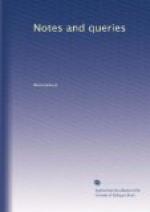The Saint is pleading against the judical ordeal:
“Illi autem profecti, praedicaverunt ubique Domino cooperante; annuntiataque est ab eis omni creaturae; id est, cunetis nationibus mundi; una fides indita per Deum, una spes diffusa per Spiritum Sanctum in cordibus credentium, una caritas nata in omnibus, una voluntas, accensum unum desiderium, tradita una oratio; ut omnes omnino ex diversis gentibus, diversis conditionibus, diverso sexu, nobilitate, honestate, servitute diversa, simul dicant uni Deo, et Patri omnium; Pater Noster qui es, &c., sicut unum Patrem invocantes, ita unam santificationem quaerentes, unum regnum postulantes, unam adimpletionem voluntatis ejus, sicut fit in coelo optantes; unum sibi panem quotidianum dari precantes et omnibus dimitti debita.”
To which other passages might be added, as, in fact, S. Agobard pursues the one idea until he hunts it down to the one effect of sameness and common antithesis. Should we say Lord Plunket had read these passages, and is thereby convicted of eloquent plagiary? I say, No! Lauder then equally convicted Milton of trespassing on the thoughts of others, by somewhat apposite quotations from the classics. We are, in truth, too much inclined to this. The little, who cannot raise themselves to the stature of the great, are apt to strive after a socialist level, by reducing all to one same standard—their own. Truth is common to all ages, and will obtain utterance by the truthful and the eloquent throughout all time.
S.H.
Athenaeum, August 12.
* * * * *
NOTES ON THE SECOND EDITION OF MR. CUNNINGHAM’S HANDBOOK OF LONDON
14. Long Acre. Mr. Cunningham, upon the authority of Parton’s History of St. Giles’s, says:
“First known as the
Elms, then called Seven Acres, and since
1612, from the length of a
certain slip of ground, then first
used as a public pathway,
as Long Acre.”
The latter part of this statement is incorrect. The Seven Acres were known as Long Acre as early as 1552, when they were granted to the Earl of Bedford. See Strype, B. vi. p. 88.
Machyn, in his Diary, printed by the Camden Society, p. 21., under the date A.D. 1556, has the following allusion to the Acre:
“The vj day of December the Abbot of Westminster went a procession with his convent. Before him went all the Santuary men with crosse keys upon their garments, and after went iij for murder: on was the Lord Dacre’s sone of the North, was wypyd with a shett abowt him for kyllyng of on Master West, squyre, dwellyng besyd ... and anodur theyff that dyd long to one of Master Comtroller ... dyd kylle Recherd Eggylston the Comtroller’s tayller, and kylled him in the Long Acurs, the bak-syd Charyng Crosse.”
15. Norfolk House, St. James’s Square. The present Norfolk House was built from a design by R. Brettingham, in 1742, by Thomas Duke of Norfolk, and finished by his brother Edward in 1762. Mr. Cunningham speaks as if the old house, in which George III. was born, was still standing.




